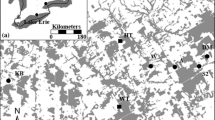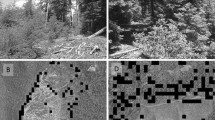Abstract
Effects of habitat edge may influence habitat quality, but landscape-scale implications of edge effects have rarely been quantified. Sprague’s pipit (Anthus spragueii), a grassland obligate songbird, is declining rapidly throughout its range. Although habitat loss is implicated in the decline, the causes are not well understood. We conducted 290 point counts across a 120 × 130 km study area in southern Alberta, Canada, between 2000 and 2002, and used nonlinear regression to determine effects of distance to water, roads, and cropland or forage habitats on relative abundance of Sprague’s pipits. We then used a geographic information system (GIS) to determine the effect of edges on habitat suitability as indexed by relative abundance. Sprague’s pipit relative abundances declined by 25% from the maximum predicted relative abundance within 900 m (CI = 660–1,280) of croplands or forage crops, and 340 m (CI = 280–460) of wetlands, but there was no effect of roads. Fewer than 1% of grassland patches in the study area contained any habitat far enough away from edge that they would be predicted to support at least 75% of the relative abundance of pipits expected in the absence of edge effects. Only 33% of the landscape can support 75% or more of the relative abundance expected in the absence of edge effects, as a result of habitat conversion or edge effects. Sprague’s pipit populations may be declining in part because edge effects greatly magnify effects of habitat loss.



Similar content being viewed by others
References
Beyer H (2003) Hawth’s analysis tools. Available from www.SpatialEcology.com. Accessed Mar 2004
Bolger DT, Scott TA, Rotenberry JT (1997) Breeding bird abundance in an urbanizing landscape in coastal southern California. Conserv Biol 11:406–421
Bollinger EK, Gavin TA (2004) Responses of nesting bobolinks (Dolichonyx oryzivorus) to habitat edges. Auk 121:767–776
Burnham KP, Anderson (1998) Model selection and inference:a practical information-theoretic approach. Springer, New York
Centre for Topographic Information (2000) Updated road network (URN) product standards, edition 1.0. Natural Resources Canada, Quebec. Available from www.cits.rncan.gc.ca/cit/servlet/CIT/site_id=01&page_id=1-005-002-008.html. Accessed Oct 2002
Davis SK (2004) Area sensitivity in grassland passerines: effects of patch size, patch shape, and vegetation structure on bird abundance and occurrence in southern Saskatchewan. Auk 121:1130–1145
Davis SK, Duncan DC, Skeel M (1999) Distribution and habitat associations of three endemic grassland songbirds in southern Saskatchewan. Wilson Bull 111:389–396
Davis SK, Brigham RM, Shaffer TL, James PC (2006) Mixed-grass prairie passerines exhibit weak and variable responses to patch size. Auk 123:807–821
Environment Canada (2005) Guidance document of statistical methods for environmental toxicity tests. Method development and applications section, Environmental Technology Centre, Environment Canada. EPS 1/RM/46
Ewers RM, Didham RK (2007) The effect of fragment shape and species’ sensitivity to habitat edges on animal population size. Conserv Biol 21:926–936
Ewers RM, Didham RK (2008) Pervasive impact of large-scale edge effects on a beetle community. Proc Natl Acad Sci 105:5426–5429
Fahrig L (2003) Effects of habitat fragmentation on biodiversity. Annu Rev Ecol Evol Syst 34:487–515
Fletcher RJ Jr, Koford RR (2003) Spatial responses of bobolinks (Dolichonyx oryzivorus) near different types of edges in northern Iowa. Auk 120:799–810
Fontaine AL, Kennedy PL, Johnson DH (2004) Effects of distance from cattle water developments on grassland birds. J Range Manag 57:238–242
Gates LW, Gysel JE (1978) Avian nest dispersion and fledging success in field-forest ecotones. Ecology 59:871–883
Gelbard JL, Harrison S (2003) Roadless habitats as refuges for native grasslands: interactions with soil, aspect, and grazing. Ecol Appl 13:404–415
Hoekstra JM, Boucher TM, Ricketts TH, Roberts C (2005) Confronting a biome crisis: global disparities of habitat loss and protection. Ecol Lett 8:23–29
Hoover JP, Tear TH, Baltz ME (2006) Edge effects reduce the nesting success of Acadian flycatchers in a moderately fragmented forest. J Field Ornithol 77:425–436
Hutto RL (1998) Using landbirds as an indicator species group. In: Marzluff Salabanks (ed) Avian conservation: research and management. Island Press, Covelo
Jensen WE, Cully JF Jr (2005) Density-dependent habitat selection by brown-headed cowbirds (Molothrus ater) in tallgrass prairie. Oecologia 142:136–149
Johnson DH (2008) In defense of indices: the case of bird surveys. J Wildl Manage 72:857–868
Johnson DH, Igl LD (2001) Area requirements of grassland birds: a regional perspective. Auk 118:24–34
Koper N, Schmiegelow FKA (2006) Effects of habitat management for ducks on target and non-target species. J Wildl Manage 70:823–834
Koper N, Schmiegelow FKA, Merrill EH (2007) Residuals cannot distinguish between ecological effects of habitat amount and fragmentation: implications for the debate. Landscape Ecol 22:811–820
Laurance WF, Yensen E (1991) Predicting the impacts of edge effects in fragmented habitats. Biol Conserv 55:77–92
Linnen CG (2008) Effects of oil and gas development on prairie birds. Report to the Petroleum Technology Alliance of Canada, Calgary, p 26
Martin TE (1998) Are microhabitat preferences of coexisting species under selection and adaptive? Ecology 79:656–670
McGarigal K, Cushman SA (2002) Comparative evaluation of experimental approaches to the study of habitat fragmentation effects. Ecol Appl 12:335–345
Owens RA, Myres MT (1973) Effects of agriculture upon populations of native passerine birds of an Alberta fescue grasslands. Can J Zool 51:697–713
Prairie Farm Rehabilitation Administration—Agriculture Agri-Food Canada (2002). PFRA ungeneralized landcover for the Canadian Prairies, Regina
Quinn GP, Keough MJ (2002) Experimental design and data analysis for biologists. Cambridge University Press, New York
Reed JM, Blaustein AR (1997) Biologically significant population declines and statistical power. Conserv Biol 11:281–282
Renfrew RB, Ribic CA, Nack JL (2005) Edge avoidance by nesting grassland birds: a futile strategy in a fragmented landscape. Auk 122:618–636
Robbins MB, Dale BC (1999) Sprague’s pipit (Anthus spragueii). In: Poole A, Gill F (eds) The birds of North America, no. 439. The Academy of Natural Sciences and The American Ornithologists’ Union, Philadelphia, pp 1–16
SAS Institute Inc. (2003) The SAS system for windows version 9.2. SAS Institute Inc., Cary
Sauer JR, Hines JE, Fallon J (2008) The North American breeding bird survey, results and analysis 1966–2007. Version 5.152.2008. USGS Patuxent Wildlife Research Center, Laurel
Slud EV, Byar DP, Green SB (1984) A comparison of reflected versus test-based confidence intervals for the median survival time, based on censored data. Biometrics 40:587–600
Storch I, Woitke E, Krieger S (2005) Landscape-scale edge effect in predation risk in forest-farmland mosaics of central Europe. Landscape Ecol 20:927–940
Thomas L, Juanes F (1996) The importance of statistical power analysis: an example from animal behaviour. Anim Behav 52:856–859
Tischendorf L (2001) Can landscape indices predict ecological processes consistently? Landscape Ecol 16:235–254
Turner MG (2005) Landscape ecology: what is the state of the science? Annual review of ecology. Evol Syst 36:319–344
Van den Berg LJL, Bullock JM, Clarke RT, Langston RHW, Rose RJ (2001) Territory selection by the Dartford warbler (Sylvia undata) in Dorset, England: the role of vegetation type, habitat fragmentation and population size. Biol Conserv 101:217–228
Winter M, Johnson DH, Faaborg J (2000) Evidence for edge effects on multiple levels in tallgrass prairie. Condor 102:256–266
Acknowledgments
We thank the many research assistants who collected data, and landowners and leaseholders, for their support. J. Ruth drew our attention to the importance of Sprague’s pipits’ aerial display. B. Dale, S. Davis, B. Cade, editors, and 3 other anonymous reviewers provided editorial recommendations on earlier drafts. Support was provided by Ducks Unlimited Canada, The North American Waterfowl Management Plan, Alberta Sport, Recreation, Parks and Wildlife Foundation, Antelope Creek Habitat Development Area, Science Horizons and Summer Career Placements (Environment Canada), the Prairie Farm Rehabilitation Administration, Natural Sciences and Engineering Research Council, John and Patricia Schlosser Environment Scholarship, Izaak Walton Killam Memorial Scholarship, Bill Shostak Wildlife Award, Richard H. G. Bonnycastle Graduate Fellowship (Institute for Wetland and Waterfowl Research, Ducks Unlimited), Margaret (Peg) Brown Award in Environmental Studies and Wildlife Resources, Ralph Steinhauer Award, the University of Alberta Walter H. Johns Graduate Fellowship, and the Universities of Alberta and Manitoba.
Author information
Authors and Affiliations
Corresponding author
Rights and permissions
About this article
Cite this article
Koper, N., Walker, D.J. & Champagne, J. Nonlinear effects of distance to habitat edge on Sprague’s pipits in southern Alberta, Canada. Landscape Ecol 24, 1287–1297 (2009). https://doi.org/10.1007/s10980-009-9375-3
Received:
Accepted:
Published:
Issue Date:
DOI: https://doi.org/10.1007/s10980-009-9375-3




